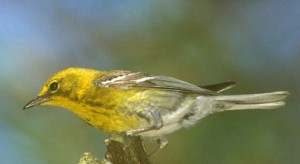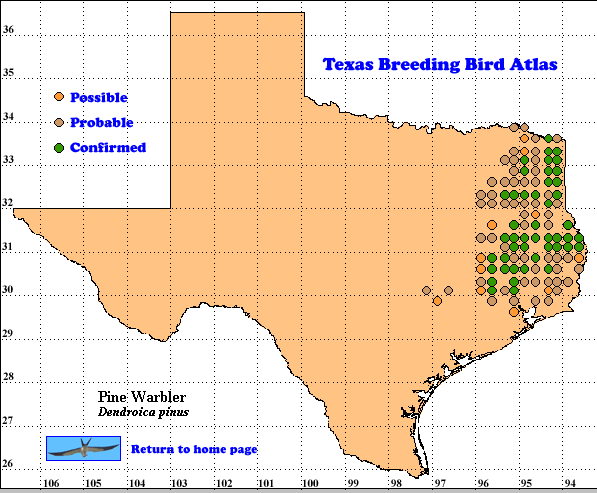Pine Warblers are strongly associated, as their name implies, with pine forests. Nests are almost always in pine trees, where this warbler also forages for insects and spiders on bark and needles or by aerial sallying. Northern populations migrate to the southern tier of states and the Carolinas for the winter where they may also forage in deciduous trees and on the ground (Rodewald et al. 1999).
DISTRIBUTION. During the 1987-1992 field work seasons of the TBBA project, observers found breeding evidence for Pine Warblers throughout the Pineywoods and in the adjoining Post Oak Savannah and Blackland Prairies region (see the region map in Lockwood and Freeman [2004]) as well as in the “Lost Pines” area centered on Bastrop County. The TBBA map is similar to that derived from North American Breeding Bird Survey (BBS) data (Sauer et al. 2005). Both maps may indicate a larger breeding range than that indicated by breeding and summer symbols on Oberholser’s (1974) map. TBBA atlasers found about 65 confirmed, 161 probable and 57 possible breeding records.
Pine Warblers also breed in many eastern states and provinces, most commonly in pinelands of Atlantic and Gulf coast states from New England to Louisiana and in Arkansas and Oklahoma, the Bahama Islands and Hispaniola (Rodewald et al. 1999, Sauer et al. 2005). This warbler winters in the coastal states from southern New Jersey and Virginia to Texas and Missouri, Kansas, Arkansas and Oklahoma (Rodewald et al. 1999
SEASONAL OCCURRENCE: Most wintering Pine Warblers depart from mid-March to late April. Resident Pine Warblers breed from late March to late July (TBBA observers found confirmed breeding from April 5 to July 10) Winter visitors return from late September to late November. The winter range in eastern Texas is more extensive than the breeding range since habitat preferences are less stringent in winter (Oberholser 1974, Lockwood and Freeman 2004).
BREEDING HABITAT. In Texas Pine
Warblers breed from near sea level to 120 m (400 ft) in lowland pine forests (Oberholser 1974). Nests are almost always built in pine trees, saddled on a horizontal limb and usually well away from the trunk. Most nests are 9-15 m (30-50 ft) above ground, hidden from below in a clump of needles. The neat structure is built of fine grasses and rootlets, forb stems, bark strips, pine needles and twigs and spider silk. It is lined with plant down, hair, pine needles and feathers. The outside diameter is 7.1 cm (2.8 in) and inside diameter 3.9 cm (1.6 in; Harrison 1979; Rodewald et al. 1999).
The female usually lays 4 (range 3-5) smooth, greenish or grayish to pure white eggs, speckled, spotted or blotched most commonly near the large end (see Harrison [1979] for a photo of markings). Parasitism by Brown- headed Cowbird (Molothrus ater) is infrequent (Harrison 1979, Rodewald et al. 1999).
STATUS. In Texas Pine Warblers are common residents in pine woods of eastern Texas and in winter this species is uncommon to common in east Texas west to Travis and Parker counties and less common southward and westward (Lockwood and Freeman 2004). BBS data from 1980-2005 strongly suggests a +3.5% annual population change for this warbler in the last quarter century (Sauer et al. 2005), certainly consistent with a range expansion. This warbler will apparently continue to breed in east Texas as long as pine forests are present. Text by Robert C. Tweit (2007)
Sauer, J. R., J. E. Hines, and J. Fallon. 2005. The North American Breeding Bird Survey, results and analysis 1966-2005. Version 6.2 2006. USGS Patuxent Wildlife Research Center, Laurel MD < http://www.mbr-pwrc.usgs.gov/bbs>

